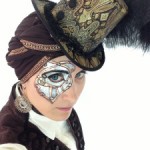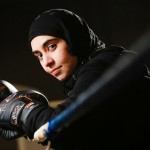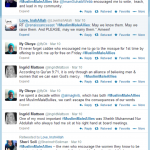This was written by Mohammed Ayish and originally published in The National.
Most Arabs are resigned to being stereotyped by western media, but for Arab women the problem is particularly acute.
I was invited to Doha in Qatar last week to present the Arab Women Media Strategy at a conference called East and West: Women in Media’s Eye. My assumption beforehand was that the event would be yet another platform to expose the misrepresentation of women in Arab media: and the discussions were indeed inspired by research revealing long-standing media stereotypes of women in the region. But one issue raised by speakers that I found intriguing was western media portrayals of immigrant Arab women in North America and Europe.
Arab women in immigrant communities, just as in this region, are the victims of negative gender-based media representations, but on top of that they face yet more negative media coverage based on cultural misconceptions and the recent political conflicts that have marred Arab-Western relations. This is rather a thorny topic, and I commend the Rome-based international cultural association Reset Dialogues on Civilisations and Northwestern University in Qatar for initiating these discussions.
I believe that for media stereotypes of immigrant Arab women to receive appropriate attention, the issue has to be addressed in its cultural and political entirety, within the broad debate about Arab media stereotypes in the West. As long as negative Arab images continue to appear in western public spheres, women in immigrant communities will continue to suffer from them. One credible response to this challenge is the Network of Arab Women in Diaspora (NAWD) project launched last year by Sheikha Fatima bint Mubarak, who chairs the UAE General Women’s Union. Among other things, the project harnesses the internet to initiate a cultural dialogue aimed at fostering a sense of identity among immigrant Arab women in the disapora.
At last week’s Doha conference, examples of how Arab women are portrayed in the U.S., Italian and German media went far beyond the usual gender-based stereotypes. I was dismayed to hear presenters referring to demonized images of Arab women, especially in the post-9/11 era. Both Newsweek and Time magazines portrayed Arab-Muslim women in terms of the veil/Islam, female circumcision and famine, while disregarding the contributions they made to their communities. Three different Italian RAI network shows featured images of helpless Arab women, often the victims of domestic abuse.
As to German media, Sabine Schiffer, head of that country’s Media Responsibility Institute, argued that they sensationalized the issue of Arab-Muslim women’s “oppression” as a strategy to detract attention from the abuse of women in general in the West. An image of a veiled Arab-Muslim woman demon-figure flying in the sky to wreak havoc on high-rise buildings in western cities was particularly disturbing. And an image of a crescent appearing slowly in sync with an act of domestic violence was most frustrating.
In the West, clearly, negative Arab images rooted in history are providing a base for the stereotyping of Arab women in the media. I have come across several studies that blame Orientalist traditions and recent political conflicts in the Middle East for reinforcing images of women only as belly dancers and concubines. One of those studies, published in 2004 by Maram Hallak (an Arab American) and Kathryn Quina, chronicles the immediate post-9/11 experience of seven young Muslim women students at a community college in lower Manhattan, next to the Twin Towers. The study shows how those young women were frustrated by media stereotyping, afraid for their safety, and distressed by the trauma they had experienced themselves from living next to Ground Zero.
A short documentary film screened at the Doha conference, on how Hollywood stereotypes Arabs, proved insightful for audiences keen on understanding the broad context that gives rise to negative images of immigrant Arab women in western media. The film, featuring the internationally renowned Arab American media scholar Jack Shaheen, notes that since the 1970s Muslims and Arabs have generally been portrayed in US media as violent, aggressive, villainous, ugly, and even sub-human. Many critics, including Professor Shaheen, blame the media for inventing and perpetuating the stereotypes that have largely shaped America’s images of many minorities, including Arabs.
Arab women in immigrant communities cannot win the fight for better media recognition while they continue to be viewed inside the parameters of traditional Arab-Islamic stereotypes. So for this issue to receive the widest attention, it has to be positioned within the broad discussion of Arab-Muslim media misrepresentations in the West. More systematic and comprehensive cultural dialogues between the West and the region are needed to reinforce common ground and avert potential misunderstandings. I see Sheikha Fatima’s NAWD initiative as a promising milestone on this path.














